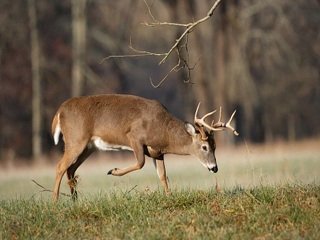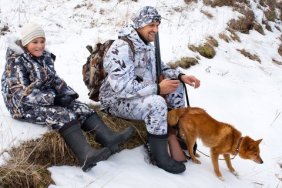 Effective hunting requires effective scouting, but when it comes to reading and interpreting deer trails, bigger is not always better. It is easy to believe that the more deer the merrier, but trophy bucks operate on their own covert ways during most hunting seasons. If they are not nocturnal or holed up in deep cover, you can bet that they are not mingling with the deer that make all those large trails. Before setting up your tree stand near that big, irresistible junction of well-worn deer trails, check out those small, underwhelming trails that run parallel to the major travel paths.
Effective hunting requires effective scouting, but when it comes to reading and interpreting deer trails, bigger is not always better. It is easy to believe that the more deer the merrier, but trophy bucks operate on their own covert ways during most hunting seasons. If they are not nocturnal or holed up in deep cover, you can bet that they are not mingling with the deer that make all those large trails. Before setting up your tree stand near that big, irresistible junction of well-worn deer trails, check out those small, underwhelming trails that run parallel to the major travel paths.
A trophy buck is at the top of the deer herd hierarchy. He only needs other deer in his life during mating season; otherwise, he is mostly a loner who only tolerates the company of other deer. The most he can benefit from being temporarily accompanied by other deer is that he will have additional eyes, ears and noses detecting potential danger.
If you constantly accept that fact that a trophy buck does not need the company of other deer, you will start to change your normal scouting techniques. Almost every major deer trail has a smaller, less conspicuous deer trail running parallel to it on the prevailing downwind side. Sometimes these small buck trails are as close as 20 feet away, but most are located up to a hundred yards away.
In fact, they can seem so far away from main trails, they can often be dismissed as coincidental or occasionally-used trails, but this is not true. Trophy bucks use these benign-looking trails as their main travel routes and they use them to scent check what the other deer are doing in regards to feeding and gathering. Trophy bucks may not need the company of other deer, but they do have a natural instinct to keep track of other deer in their core areas.
A very effective way to scout these trails when you find them is to clear out small sections of the trail from grass, sticks and other ground debris. With a bare dirt spot, you can observe what size tracks are being made. You can also figure out the prevailing wind and set up a silent trail camera on the downwind side of the trail. Another low-impact scouting tactic is to simply find out where one of these trails crosses a creek so you can not only observe naturally made tracks, but also get an indication of what direction the buck travels after crossing the creek. Remember, a creek is a natural obstacle and if you can find out where a buck likes to cross, you can create another potential set-up spot to hang your stand. It never hurts to have multiple stands when trophy hunting, because you can choose which stand to hunt based on the daily wind direction.
If you want to kill a big trophy Whitetail buck, look for that small trophy Whitetail trail off the beaten path.








